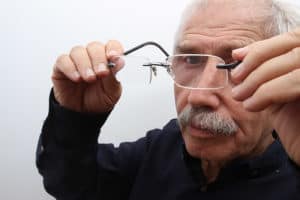Vision correction plays a pivotal role in enhancing our daily lives, allowing us to see clearly and perform tasks with ease. As we age, the need for effective corrective lenses becomes increasingly vital. Among the various options available, varifocal lenses have gained significant popularity due to their ability to address multiple vision problems seamlessly.
It is a fundamental aspect of maintaining quality of life, especially as we encounter common vision issues like myopia (nearsightedness), hyperopia (farsightedness), and presbyopia (age-related vision loss). Corrective lenses are designed to compensate for these conditions, providing clear vision at different distances.
How the Human Eye Works?
The human eye functions like a sophisticated camera, with light entering through the cornea and lens, focusing onto the retina where images are formed and transmitted to the brain. This intricate process enables us to perceive the world around us in varying degrees of clarity.
Common Vision Problems
Myopia causes distant objects to appear blurry, while hyperopia results in difficulty focusing on close-up objects. Presbyopia typically affects individuals over 40, leading to the inability to focus on near objects due to changes in the eye’s lens elasticity.
- Myopia (Nearsightedness): Myopia causes distant objects to appear blurry. It occurs when the eyeball is too long or the cornea is too curved, causing light rays to focus in front of the retina instead of on it. This condition makes activities like driving or watching TV challenging without corrective lenses.
- Hyperopia (Farsightedness): Hyperopia results in difficulty focusing on close-up objects. It happens when the eyeball is too short or the cornea is too flat, causing light to focus behind the retina rather than directly on it. People with hyperopia may struggle with tasks like reading or using a computer without corrective eyewear.
- Presbyopia: Presbyopia typically affects individuals over 40 and is caused by the natural ageing process affecting the eye’s lens elasticity. This leads to the inability to focus on near objects. People with presbyopia may find themselves holding reading materials at arm’s length to see them clearly or needing bifocals or varifocal lenses to correct their vision for both near and far distances.
Need for Corrective Lenses as We Age
As we grow older, our eyes undergo natural changes that affect our ability to see clearly at all distances. Corrective lenses, such as varifocal lenses, become essential tools in managing these changes and maintaining optimal visual acuity.
What are Varifocal Lenses?
Varifocal lenses, also known as progressive lenses, are innovative eyewear designed to provide a seamless transition between different focal distances. Unlike traditional lenses that have distinct zones for near and far vision (e.g., bifocal lenses), varifocal lenses feature a gradual change in lens power from top to bottom, catering to near, intermediate, and distance vision needs within a single lens.
Differences Between Varifocal, Bifocal, and Single Vision Lenses
Varifocal lenses differ significantly from bifocal and single-vision lenses in terms of functionality and design. Bifocal lenses have two distinct optical powers separated by a visible line, typically addressing near and distant vision. Single-vision lenses, on the other hand, have a uniform optical power throughout the lens, suitable for correcting either nearsightedness or farsightedness.
Benefits of Varifocal Lenses for Various Vision Issues
Varifocal lenses offer several advantages for individuals with multiple vision issues. By eliminating the abrupt transition between different optical powers seen in bifocal lenses, varifocals provide a smoother, more natural visual experience. They are particularly beneficial for those with presbyopia, as they allow seamless focusing across different distances without the need for multiple pairs of glasses.
Varifocal lenses also enhance aesthetics compared to bifocals, as they lack visible segment lines that can be distracting or cosmetically unappealing. This feature makes varifocals a preferred choice for individuals who prefer a more discreet and modern eyewear solution.
In addition to their functional benefits, varifocal lenses contribute to overall visual comfort and convenience. Wearers can effortlessly shift their gaze from reading materials up close to objects in the distance, making varifocal lenses ideal for everyday activities that require frequent changes in focal distance.
Technology Behind Varifocal Lenses
Varifocal lenses, also known as progressive lenses, represent a significant advancement in vision correction technology. They are designed to address multiple vision needs within a single lens, providing a seamless transition between different focal distances. In this section, we will explore the intricate technology and advanced materials that make varifocal lenses an essential tool for those with varying vision requirements.
Design and Structure of Varifocal Lenses
Varifocal lenses are characterised by their smooth gradient of lens power, which allows wearers to see clearly at different distances without the abrupt shifts typical of bifocal lenses. Unlike single vision lenses that correct vision at one distance, varifocal lenses integrate multiple prescriptions into a continuous surface. The upper part of the lens is tailored for distance vision, the middle for intermediate vision, such as computer work, and the lower portion for near vision tasks like reading.
The design of varifocal lenses involves a complex curvature that gradually changes across the lens surface. This curvature ensures a natural progression of vision correction, minimising distortion and optimising visual clarity. By accommodating different focal points in a single lens, varifocal lenses eliminate the need for users to switch between multiple pairs of glasses for different activities.
Achieving Gradual Change in Lens Power
The gradual change in lens power in varifocal lenses is achieved through sophisticated optical engineering. Traditional lenses, such as bifocals, have distinct zones with abrupt transitions between different powers. In contrast, varifocal lenses utilise a continuous gradient where the power changes progressively from top to bottom and from the centre to the periphery of the lens.
This progressive design allows for a smooth and natural adjustment of the eyes as they move between different distances. It significantly enhances visual comfort and reduces visual disturbances that can occur with traditional multifocal lenses. Users experience improved vision clarity at all distances, making varifocal lenses particularly beneficial for individuals with presbyopia, a common age-related condition that affects near vision.
Advanced Technology and Materials
The effectiveness of varifocal lenses is also attributed to the advanced technology and high-quality materials used in their manufacturing. Modern varifocal lenses are crafted using precision optics and computer-assisted design (CAD) technology, which ensures accurate prescription customisation and optimal lens performance.
Materials such as high-index plastics and polycarbonates are commonly used to create varifocal lenses that are lightweight, durable, and thin. These materials contribute to the comfort and aesthetics of the lenses, making them suitable for a wide range of frame styles and wearer preferences.
Comparison with Traditional Lenses
When comparing varifocal lenses with traditional lenses like bifocals or trifocals, the advantages of varifocals become clear. Traditional multifocal lenses have distinct lines or segments that separate different prescription powers, which can be visible and aesthetically displeasing. These lines can also cause image jumps or distortion when the eyes move between different zones of the lens.
In contrast, varifocal lenses eliminate these issues by providing a smooth, uninterrupted transition between vision zones. This seamless integration enhances visual comfort and allows for a more natural visual experience. Wearers can enjoy clearer vision across a wide range of distances without the drawbacks associated with traditional multifocal lenses.
How Varifocal Lenses Improve Vision
Varifocal lenses excel in providing a seamless transition between different focal points. Whether you’re driving, using a computer, or reading a book, varifocal lenses ensure clarity at all distances. Users often report enhanced visual comfort and adaptability, as these lenses cater to various daily activities without the hassle of switching eyewear.
Real-life examples highlight the practical benefits of varifocal lenses. Imagine effortlessly switching focus from your computer screen to a colleague across the room, or seamlessly reading a recipe while preparing ingredients in the kitchen. Varifocal lenses empower wearers to maintain natural eye movements, mimicking the way eyes naturally adjust to different distances.
Exploring Lens Design and Technology
The effectiveness of varifocal lenses lies in their sophisticated design and advanced technology. Manufacturers utilise precise measurements and calculations to optimise lens curvature and power distribution. This precision ensures that wearers experience minimal distortion and maximum visual acuity across all viewing zones.
Role of Lens Coating in Performance
Lens coatings play a crucial role in enhancing the performance and durability of varifocal lenses. Anti-reflective coatings reduce glare from digital screens and nighttime driving, while hydrophobic coatings repel water and dirt, keeping lenses clearer for longer. UV coatings provide essential protection from harmful sun rays, safeguarding both eye health and lens longevity.
Conclusion
Varifocal lenses represent a significant advancement in vision correction technology, offering wearers a seamless and effective solution for multifocal vision needs. From improved clarity to enhanced comfort, these lenses cater to a diverse range of daily activities without compromising style or functionality.
For those considering varifocal lenses, consult with an optometrist to determine the best option based on your specific vision requirements and lifestyle. Embrace the freedom of clear, natural vision at all distances with varifocal lenses, and experience life with enhanced clarity and comfort. Whether you’re navigating work tasks, enjoying hobbies, or simply exploring the world around you, varifocal lenses adapt to your vision needs seamlessly.
If you’re looking to reglaze your glasses with varifocal lenses or other options, consider Reglaze 4 U. They specialise in online reglazing services, offering a variety of lens types including single vision, bifocal, and varifocal lenses. Whether you need new lenses for everyday glasses or speciality frames like Oakley or wrap-style frames, Reglaze 4 U provides high-quality materials and scratch-resistant lenses. Contact them today at 0116 367 6015 or email info@reglaze4u.com to discuss your reglazing needs and discover how they can help you see clearly again.




